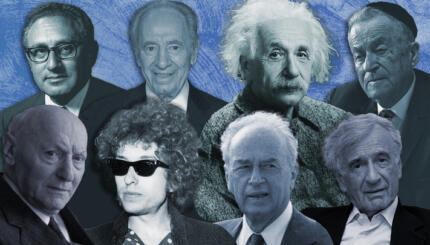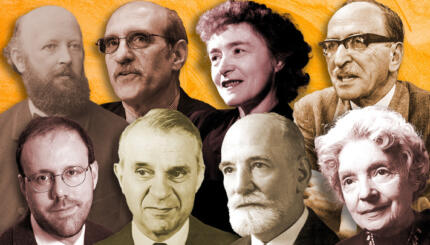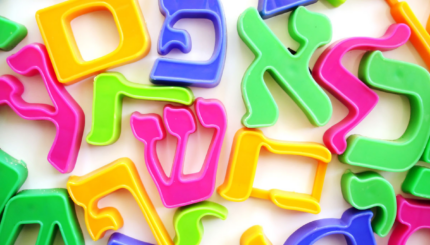Modern Jewish children’s literature first emerged in America less than 100 years ago, when The Adventures of K’tonton, by Sadie Rose Weilerstein, was published in 1935. Relative to the classics of mainstream children’s literature, Jewish children’s literature is much younger, having stood the test of decades, not centuries. Despite this newness, there is a robust selection of Jewish children’s books that have become classics to several generations of readers.
From the Smallest
Weilerstein’s unruly, thumb-sized K’tonton was modeled physically after an S. Y. Agnon character, the tiny Rabbi Gadiel Hatinok. But unlike Agnon’s character, who bravely battled anti-Semitism, Weilerstein’s is a mischievous Jewish child who leads his loving parents and readers on a merry chase through the Jewish holidays.
K’tonton takes a ride on the chopping knife his mother is using to make gefilte fish for dinner; sneaks off to the synagogue at and gets swung about on a lulav; goes for a ride on a runaway dreidel during ; falls into a bowl of hamentaschen batter on Purim; barely escapes being locked up in the basement with the everyday dishes during Passover; and takes flight on an arrow at a Lag Ba’Omer picnic.
Fantasy abounds in the K’tonton stories, distinguishing them from the stoic bible stories that previously dominated Jewish children’s literature. The viewpoint is proudly and affirmatively Jewish. As an old woman in a synagogue says while watching K’tonton, “A wonder child…Even when he runs away, where does he run to? The synagogue!” Today’s audience can experience the whimsy of these original stories in The Best of K’tonton (1980).

Help us keep Jewish knowledge accessible to millions of people around the world.
Your donation to My Jewish Learning fuels endless journeys of Jewish discovery. With your help, My Jewish Learning can continue to provide nonstop opportunities for learning, connection and growth.
Holiday Reading
Since K’tonton, a whole host of other books about the holidays have been written for Jewish children. Author Barbara Cohen wrote two beloved classics for young readers, The Carp in the Bathtub (1972), a Passover story, and Molly’s Pilgrim (1983), which touches on the similarities between Thanksgiving and Sukkot.
“Could you eat a friend?” is the question that drives The Carp in the Bathtub, when a sister and brother decide that they can’t let a carp that they love like a pet become the family’s Passover gefilte fish. Set during the Depression, the tongue-in-cheek humor, animated characterization, and compelling story still win the affection of readers.
Molly’s Pilgrim has a sadder tone as its main character is a Jewish immigrant child who is picked on at school for being different. Two strong women in the story, an understanding teacher and a loving mother, are pivotal characters who, each in her own way, convince Molly’s classmates that Jewish immigrants are not so different from the American Pilgrims they study and admire.
All-of-a-Kind Reading
Yet, the best known and most widely read of Jewish children’s classics focus on family–Sydney Taylor’s five All-of-a-Kind Family books (1951-1978). The author based them on her own experiences growing up in a large Jewish family in the early 20th century. In the series, Mama and Papa are hard working immigrants and parents to six lively children.
As newcomers, the kids and their parents work to adjust to American society while remaining faithful to their Jewish heritage. In All-of-a-Kind Family Downtown, for example, the sisters reach out to Guido, a poor Italian boy struggling to care for his sick mother, by inviting him to join in decorating their Sukkah on Manhattan’s Lower East Side.
Throughout the five books, the family grows and changes while retaining the strong bonds that love and shared traditions create. The All-of-a-Kind Family books were the first Jewish children’s books to cross over into mainstream literature. Taylor legacy’s has been honored with the creation of the Association of Jewish Libraries’ Sydney Taylor Book Award, which recognizes outstanding Jewish children’s literature annually.
Holocaust Literature
Just as the Holocaust shaped modern Jewish history, its impact runs deep in the literary world. Anne Frank’s The Diary of a Young Girl (1952) marked the beginning of an outpouring of Holocaust memoirs, fiction, biographies, and non-fiction accounts–many of which were written for children and young adults.
A classic of that genre is Esther Hautzig’s memoir of her childhood in Siberia, The Endless Steppe (1968), as well as Lois Lowry’s Number the Stars (1989), a novel about the rescue of Danish Jews. Both books achieve a balance between depicting the horror of the Holocaust and portraying the hope that gives humans the power to endure.
Holocaust stories also have been written specifically for the youngest of readers. Terrible Things (1980), an allegory for young children by Eve Bunting, is often used as a child’s first introduction to the Holocaust. Using animal characters and softly colored illustrations, Bunting tells the story of the “Terrible Things” that come to the forest, first hunting every creature with feathers on its back. Everyone except the birds remark that they don’t have feathers; maybe the forest is better without the birds. But then the Terrible Things begin singling out all of the other groups of animals, until none is left. Bunting takes her text from the famous words of Pastor Martin Niemöller:
“When the Nazis came for the communists, I remained silent; I was not a communist. When they locked up the social democrats, I remained silent; I was not a social democrat.
When they came for the trade unionists, I did not speak out; I was not a trade unionist. When they came for me, there was no one left to speak out.”
Jewish Folklore
Beginning in the middle of the 20th century, Jewish authors turned to traditional folklore for inspiration. The Wise Men of Helm and Their Merry Tales (1942) and its sequel, More Tales of the Wise Men of Helm (1965) by Solomon Simon were among the first modern collections of Jewish folklore published for children. Their dead-pan style and inexorably developed the fictional city Chelm–where is everything is backwards and humorously illogical–set the standard for other retellings of Chelm tales, of which there are many.
Isaac Bashevis Singer’s masterwork for children, Zlateh the Goat and Other Stories (1976), also brought to life tales from the Eastern European folk tradition, alongside a sprinkling of Chelm tales and stories teeming with the demons and devils that often inspired Singer’s literary imagination. The black and white illustrations by award-winning artist Maurice Sendak (Where the Wild Things Are) help to capture the soul of Jewry.
Classic Picture Books
The art of the picture book is one of the greatest achievements of modern children’s literature and is exemplified in many of the classic Jewish tales. In Something from Nothing (1993), written and illustrated by Phoebe Gilman, three different scenes unfold simultaneously through remarkable illustrations: the outsider view of shtetl life, the domestic life of a boy and his extended family, and the community of mice that lives cozily under the floor boards.
Eric Kimmel’s Hershel and the Hanukkah Goblins (1985), with haunting illustrations by Trina Schart Hyman, is based on the legendary character of Hershele Ostropoyler, known in lore as a prankster who lived in poverty and targeted the rich and powerful. In Kimmel’s version, the resourceful vagabond matches wits with a scary and dark array of goblins determined to undermine Hannukah on each of the eight nights of the holiday.
In author-illustrator Margot Zemach’s It Could Always Be Worse (1976), an unhappy man, living in a house crowded with noisy children, heeds his rabbi’s strange advice and agrees to bring farm animals inside to join the crowd. Zemach’s illustrations of chaos spill across the pages, and the detail and movement capture to perfection the tumult and eventual peace.
The classics of Jewish children’s literature represent a broad spectrum of subject, style, point of view, and artistic technique. But they all point back to the stories and traditions that have been so integral to Judaism for centuries. Although intended for children, as classics, they have something to say to readers of all ages.


